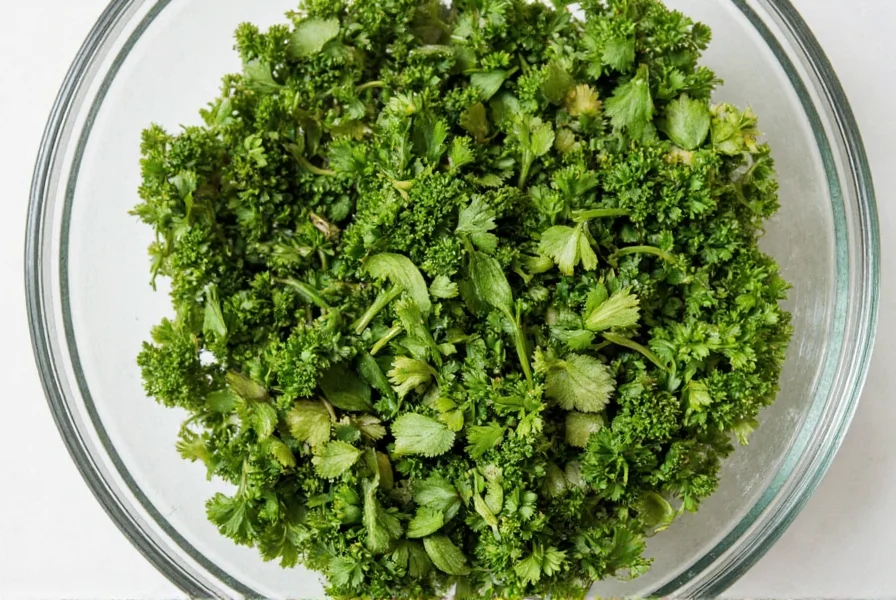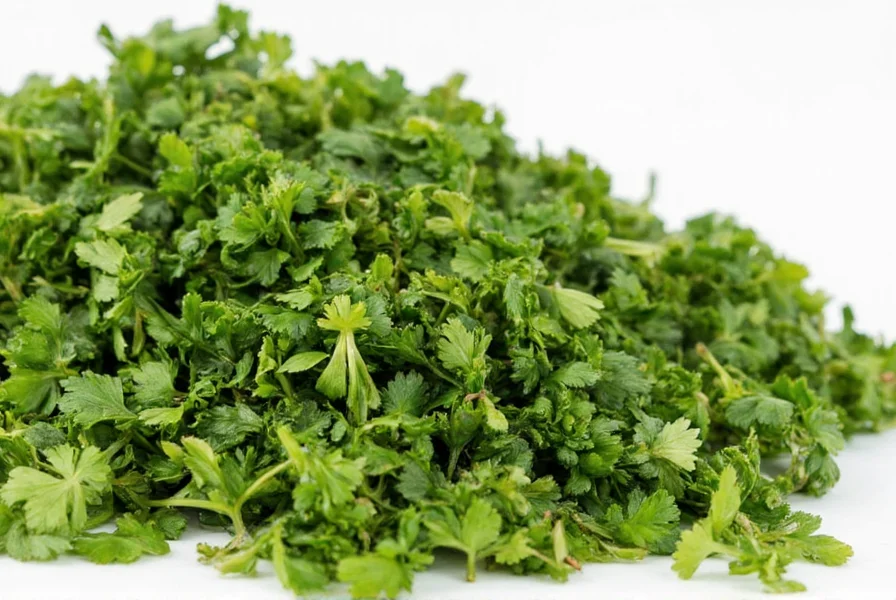Whether you're a home cook or a professional chef, dried parsley is a versatile herb that can elevate your dishes when used correctly. In this guide, we'll share 10 specific ways to use dried parsley in your cooking, with precise measurements and expert tips for maximum flavor. You'll learn how to incorporate dried parsley into soups, stews, sauces, and more — without the common mistakes that dull its flavor.
1. In Soups and Stews
Add 1 teaspoon of dried parsley during the last 10 minutes of cooking to preserve its fresh flavor. Unlike fresh parsley, which is often added at the end, dried parsley needs a bit of time to rehydrate and release its flavor. For best results, stir it in when the soup is almost done to prevent overcooking.
Pro Tip: According to culinary experts from the International Culinary Institute, dried parsley works best in tomato-based soups like minestrone or lentil soup, where it complements the acidity.
2. In Salad Dressings
Mix 1/2 teaspoon of dried parsley with 2 tablespoons of olive oil, 1 tablespoon of lemon juice, and a pinch of salt for a fresh herb dressing. Dried parsley dissolves well in oil-based dressings, releasing its flavor evenly.
Pro Tip: For maximum freshness, prepare dressings 15 minutes before serving to allow the dried parsley to rehydrate fully.
3. In Meat Rubs
Combine 1 teaspoon dried parsley with 1 teaspoon garlic powder, 1/2 teaspoon paprika, and 1/4 teaspoon black pepper for a flavorful rub on chicken or beef. The dried parsley adds a subtle herbal note that enhances the meat's natural flavors.
Pro Tip: Apply the rub 30 minutes before cooking to allow the flavors to penetrate the meat.
4. In Pasta Sauces
Stir 1 teaspoon of dried parsley into tomato-based pasta sauces during the last 5 minutes of cooking. Dried parsley pairs perfectly with Italian herbs like oregano and basil for a classic Italian flavor profile.
Pro Tip: Avoid adding dried parsley too early to prevent bitterness; it's best added when the sauce is nearly finished.
5. In Roasted Vegetables
Toss 1 teaspoon dried parsley with 1 tablespoon olive oil and your favorite vegetables before roasting. The heat from roasting activates the parsley's flavor, adding a fresh, herbal note to roasted potatoes, carrots, or Brussels sprouts.
Pro Tip: For extra crunch, sprinkle dried parsley over vegetables after roasting for a final burst of freshness.
6. In Baked Goods
Add 1/2 teaspoon dried parsley to savory breads, scones, or cheese biscuits for a subtle herbal undertone. Dried parsley works well in recipes that include cheese or herbs like chives.
Pro Tip: Mix dried parsley into dry ingredients before adding liquids to ensure even distribution.
7. In Homemade Spice Blends
Create your own seasoning mix by combining 2 tablespoons dried parsley with 1 tablespoon dried thyme, 1 teaspoon garlic powder, and 1/2 teaspoon onion powder. Store in an airtight container for up to 6 months.
Pro Tip: Use this blend as a rub for grilled meats or to season roasted vegetables for consistent flavor.
8. In Egg Dishes
Stir 1/2 teaspoon dried parsley into scrambled eggs or omelets just before serving. The delicate flavor of dried parsley complements eggs without overpowering them.
Pro Tip: For a vibrant green color, sprinkle dried parsley on top of finished egg dishes as a garnish.
9. In Marinades
Mix 1 teaspoon dried parsley with 2 tablespoons soy sauce, 1 tablespoon honey, and 1 clove minced garlic for a savory marinade for chicken or tofu. The dried parsley helps balance the sweetness and saltiness of the marinade.
Pro Tip: Marinate proteins for at least 1 hour to allow the flavors to fully develop.
10. In Grain Bowls
Stir 1 teaspoon dried parsley into cooked quinoa, rice, or farro before serving. Dried parsley adds a fresh, herbal note to grain bowls and pairs well with lemon juice and olive oil.
Pro Tip: For extra texture, mix dried parsley with toasted nuts or seeds in grain bowls for a satisfying crunch.
How to Store Dried Parsley for Maximum Freshness
Store dried parsley in an airtight glass jar away from heat, light, and moisture. Keep it in a cool, dark pantry for up to 1 year. For extended freshness, store in the freezer for up to 3 years.
Pro Tip: Test freshness by crushing a pinch between your fingers — if it releases a strong herbal aroma, it's still good to use.
| Product | Features | Advantages | Use Cases | Target Audience | Suitable Occasions |
|---|---|---|---|---|---|
| Pure Dried Parsley by Green Leaf | Whole leaves, no additives | Retains natural flavor and color | Stews, soups, meat dishes | Cooking enthusiasts, home chefs | Dinner parties, everyday cooking |
| Organic Dried Parsley by Herb Haven | Organic-certified, finely ground | Easy to use, great for baking and seasoning | Baked goods, spice blends, marinades | Health-conscious cooks, bakers | Gourmet meals, special occasions |
| Parsley Dried by Nature's Best | Highly aromatic, compact packaging | Convenient storage, long shelf life | Seasonings, sauces, dressings | Busy professionals, frequent cooks | Quick meals, meal prepping |
Frequently Asked Questions
How much dried parsley should I use compared to fresh parsley?
Generally, use 1 teaspoon of dried parsley for every 1 tablespoon of fresh parsley called for in a recipe. Dried herbs are more concentrated because the water content has been removed, so you need less. Remember to add dried parsley earlier in the cooking process to allow time for rehydration and flavor development.
How long does dried parsley last before losing its flavor?
Properly stored dried parsley maintains its best flavor for 1-2 years. After this time, it doesn't necessarily go bad, but the flavor and color will gradually diminish. To maximize shelf life, store in an airtight container away from heat, light, and moisture. You can test if your dried parsley is still good by checking for vibrant green color and a strong herbal aroma when crushed between your fingers.
What's the best way to store dried parsley to maintain freshness?
Store dried parsley in an airtight container (like a glass jar with a tight-sealing lid) in a cool, dark place away from heat sources. Avoid storing near the stove, oven, or in direct sunlight. For extended storage, you can keep dried parsley in the freezer, which helps preserve flavor and color for up to 3 years. Just be sure to let the container reach room temperature before opening to prevent moisture condensation.
Can I make my own dried parsley at home?
Absolutely! The best method is air-drying: tie fresh parsley sprigs together and hang them upside down in a warm, dry, well-ventilated area away from direct sunlight. This process takes 1-2 weeks. Alternatively, you can use a food dehydrator on the lowest setting (about 95°F/35°C) for 2-4 hours, or oven-dry at the lowest temperature with the door slightly ajar. Home-dried parsley often has better flavor than store-bought because you can dry it at peak freshness.
Why does my dried parsley turn brown so quickly?
Dried parsley turns brown primarily due to exposure to light, heat, or moisture. To prevent this, always store it in an opaque or dark-colored container, away from heat sources. The green color in parsley comes from chlorophyll, which breaks down when exposed to these elements. Using fresh, high-quality parsley when drying (if making your own) also helps maintain better color. Note that some color loss is natural over time, but significant browning indicates the parsley has lost much of its flavor potency.
Conclusion
Dried parsley is a culinary powerhouse when used correctly. By following these 10 specific techniques and expert tips, you can transform ordinary dishes into extraordinary meals. Remember to start with small amounts and adjust to taste — the key to perfect flavor is precision and timing.












 浙公网安备
33010002000092号
浙公网安备
33010002000092号 浙B2-20120091-4
浙B2-20120091-4